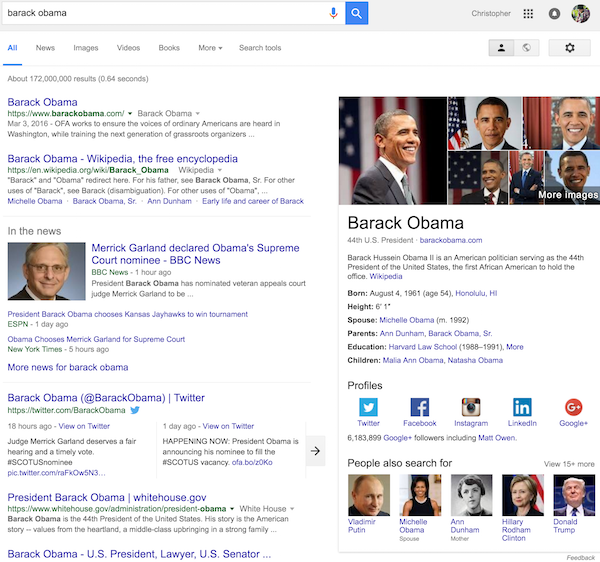Last week artificial intelligence achieved another victory over humankind.
Google DeepMind’s AlphaGo program won 4-1 against Lee Sedol, one of the best Go players in the world, in a milestone that experts thought was a decade away.
Of course, AI is about much more than winning board games. Google’s RankBrain AI powers its Knowledge Graph search results, bringing context and semantics to the traditional keyword-based search.
And with last month’s appointment of John Giannandrea, AI expert and Knowledge Graph founder, as Google’s new head of search, this is clearly an area Google is interested in.
For performance marketers, this needs to be paid attention to. Not only is Knowledge Graph an important tool that needs to be understood and utilised, but the AI powering it needs to be communicated with to ensure that it receives accurate information.
What is Knowledge Graph?
Say that you type into Google the name of a famous person, a tourist destination, a business, or any one of a whole host of objects or people that are frequently searched for. What you will most likely encounter is a panel along the side and/or the top of the results that provides additional information about what you searched for.
For example, if you search for ‘Barack Obama’, you will see a side panel with pictures, information about when and where he was born, his family, his social media profiles, as well as some ‘people also search for’ results.
Similarly, if you search for ‘Eiffel Tower’ you will get information relevant to the building, such as the address, height and opening date.
If you type a flight number, the weather, or the definition of a word, you will get a Quick Answer Box at the top of the results that gives you essential information about the concept you have searched for. And there are plenty of other queries that will trigger this type of result.
This is the Knowledge Graph. It’s essentially a database that provides relevant contextual information and facts about millions of entities from across the web and shows it in search results.
This database is built up using artificial intelligence software that scans the web, interprets what it sees, and stores the insights that it finds. Rather than simply seeing the words on a web page or in a search query, the search engine tries to understand what the sentence actually means and make smarter judgements as to which results are relevant.
Of course it’s not just Google that has this technology. Microsoft has its “Satori Knowledge Base”, Yahoo has started working on its own solution, and Wolfram Alpha has had its own smaller version of this for many years.
What does Knowledge Graph mean for performance marketing?
Knowledge Graph isn’t just an interesting concept. It’s also an online space that performance marketers need to occupy if they want to stay ahead.
Approximately 19% of search results now feature Knowledge Graph results. And on mobile, these take up a sizeable amount of screen space.
Knowledge Graph has become a prominent part of the search experience, having a significant effect on your audience’s judgement of you and your products. Reaching the top of Google search results (organically and/or through AdWords) is no longer the only objective; inaccurate or poorly optimised Knowledge Graph results could seriously undermine your brand.
Although machine learning programs do their best, they don’t always interpret what they see correctly. And this can lead to problems if Google is displaying inaccurate information about your business: an outdated phone number, for example, could cost you a lot of clients.
To make up for this, Schema.org was founded and sponsored by four of the big search giants (Google, Microsoft, Yahoo, Yandex) to create a method for websites to explicitly give search engines this semantic information. In practice, this involves adding extra code to your website to indicate what type of object you are referring to in a piece of text.
Yet surprisingly few people have made use of this tool. Even though it has been around since 2011, as many as 80% of websites still haven’t used Schema.org markup. But this isn’t something that performance marketers should overlook – making sure that Knowledge Graph results have accurate and useful information for your brand is essential.
Knowledge Graph in the future
Today if you want people to hear you, you cannot just speak to your target audience. You also need to speak to the programs that are filtering and interpreting the web for them.
Helping the top search engines understand the meaning and the context behind your website is now a key part of achieving the most beneficial results.
Knowledge Graph has a lot of room to grow and become an even more influential part of how search engines work. We can expect the range of objects it can capture information about to increase, the information gathered to expand, and for consumers to become more familiar with using Knowledge Graph panels to get what they are looking for.
We can also expect Google’s competitors to try and outperform Knowledge Panel with their own solutions.
For performance marketers, the most important thing is to stay ahead of the game. By watching how this unfolds, and checking what new features are added, what trends are developing, and what you need to do to respond, you can start outmanoeuvring your competitors in this space.
The article What performance marketers need to know about Google Knowledge Graph was first seen from https://searchenginewatch.com


No comments:
Post a Comment